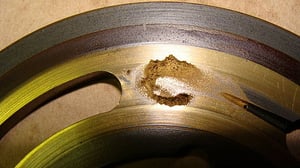Wear is inevitable, but there are ways you can keep it from accelerating in your hydraulic motor.

Here are some other Shop Talk Blog posts you might find of interest:
Brendan Case at Hydraulics & Pneumatics has an excellent article on 6 Ways Your Hydraulic Components Wear Out, but here we are focusing on just five of the most common: adhesive, abrasive, cavitation, corrosive, erosive, and fatigue.
Adhesive Wear
What it looks like: polishing, galling, scoring, scuffing
How it happens: When two surfaces are in sliding contact and there isn't enough lubricating film between them, the asperities (microscopic high points) may end up cold welding and then tearing apart. This leads to a transfer of material between the two surfaces. And in a worst-case scenario, adhesive wear can also lead to seizing between two surfaces.
What causes it: The cause of adhesive wear is a lack of lubrication leading which leads to friction, heat generation, and cold welding.
Abrasive Wear
What it looks like: scoring or scuffing
How it happens: There are two types of abrasive wear: two-body abrasion and three-body abrasion. In two-body abrasion, two surfaces come into direct contact with each other. This is usually made possible by a loss of lubricating film. In three-body abrasion, two surfaces with a clearance between them end up with a hard particle bridging the clearance.
What causes it: Two main causes lie behind abrasive wear in hydraulic equipment. For two-body abrasion, the cause is a lack of lubrication which can be caused by a variety of factors including aging, issues with viscosities, and chemical contamination. For three-body abrasion, the cause is contamination by materials such as silica carbide, aluminum oxide, and sand.

Cavitation Wear
What it looks like: pitting
How it happens: Cavitation bubbles form and then collapse in the hydraulic fluid, forming micro-jects powerful enough to displace particles from the surface of even extremely hard metals.
What causes it: Cavitation wear is caused by problems with cavitation, which can result from either poor design or the presence of contaminating air bubbles or oil-vapor bubbles that form and collapse.

Corrosive Wear
What it looks like: blackened areas or pitting
How it happens: Chemical and electrochemical reactions attack the surface of hydraulic components and primarily occur when there is both corrosion and mechanical wear present. Corrosive materials can include water, acids, and degraded additives in hydraulic fluid.
What causes it: Causes include aging hydraulic fluid, water contamination, and the effects of excessive heat on the hydraulic fluid.

Erosive Wear
What it looks like: polishing or increased clearances
How it happens: Hydraulic fluid with silt-sized (think less than 2 microns across) abrasive particles move across surfaces at a high-velocity act as a slurry that polishes the surfaces and eventually erodes away enough material to increase critical component clearances. Each particle alone will do very little damage, but combined and flowing at high speed they can do significant damage.
What causes it: Erosive wear is caused by contaminated hydraulic fluid containing an abundance of silt-sized hard particles. The abrasive particles include silica carbide, aluminum oxide, and sand.
Fatigue Wear
What it looks like: spalling, cracks, peeling
How it happens: Fatigue wear mainly affects components that are subject to heavy point loads, such as bearings and gears. Over time, those loads can weaken the surface of these components. They develop cracks and eventually pieces of material will break away, leading to spalling.
What causes it: Poor design and incorrect installation of components such as gears and bearings.

Preventing Premature Hydraulic Motor Wear
Now that we've discussed the most common forms that hydraulic motor wear takes, let's summarize the causes:
- Lack of lubrication
- Contamination
- Aging hydraulic fluid
- Excessive heat generation
- Incorrect installation of gears and bearings
- Poor design
Of these, only #6 (poor design) is something we have no control over. We can address issues with lack of lubrication by making sure we're using the right type of hydraulic fluid (e.g., the right viscosity for operating conditions, manufacturer-recommended). Contamination can be prevented. The effects of aging hydraulic fluid can be addressed by following OEM recommendations for when to flush your hydraulic system. There are ways to avoid excessive heat generation. Finally, care can be taken in the installation of gears and bearings.
Conclusion
While you can't prevent the normal wear that occurs within a final drive motor, you can keep it from accelerating. And regular maintenance is the key to doing just that.


